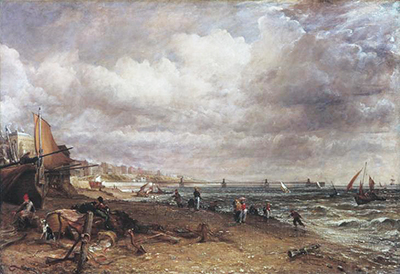Chain Pier is oil on canvas painting completed in 1827. Brighton experienced tremendous growth as a port during the 1820s and this painting is a tribute to the bustling activity on the seaside resort at the time. The painting portrays ships and seafarers working against the backdrop of the growing hotel and hospitality industry in the port city.
Chain Pier was the epitome of the thriving industry at the port and appears as a long line in the background. Constable was a regular visitor to Brighton in the 1820s and would take his wife there to lift her spirits during her long illness. He spent much time exploring the town and making sketches of the landscape. It was during one such tour that he hit on the idea of adopting a vivid style of painting on large frames. He made several drawings of Brighton but Chain Pier was the only large painting he made of Brighton.
Constable drew inspiration from the works of Claude Lorrain and Annibale Carracci but was also determined to develop a unique style. He set out to depict nature in its most natural form and reproduce scenes of ordinary citizens doing routine jobs. Chain Pier closely resembles Constable's other beach paintings such as The Gleaners, Brighton and The Sea near Brighton in its depiction of the sky as a ferocious monster ready to devour all in its path. The light colors used the background are in stark contrast to the intimidating dark hue used for the sky. His knack for capturing natural light is also very evident in this painting.
Constable was a devout of the Romantic Movement that defied the use of landscape paintings for functional purposes and preferred painting them for their intrinsic beauty. This approach is evident in the Chain Pier where appreciation of the activities on the beach supersedes the need to project the Pier as a historical artifact. This approach is evidence in his reproduction of the frenetic work by the sailors. Chain Pier, Brighton is owned by the British Museum and is available on their exhibitions around the UK.




